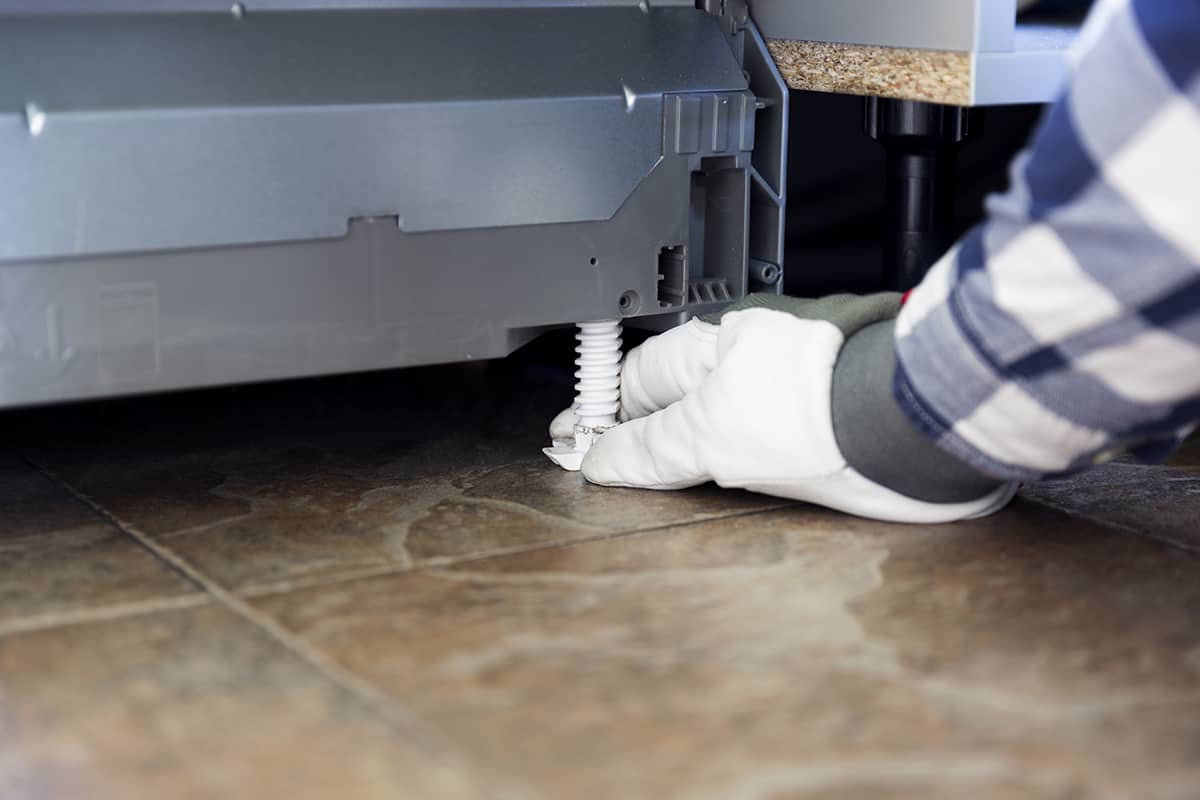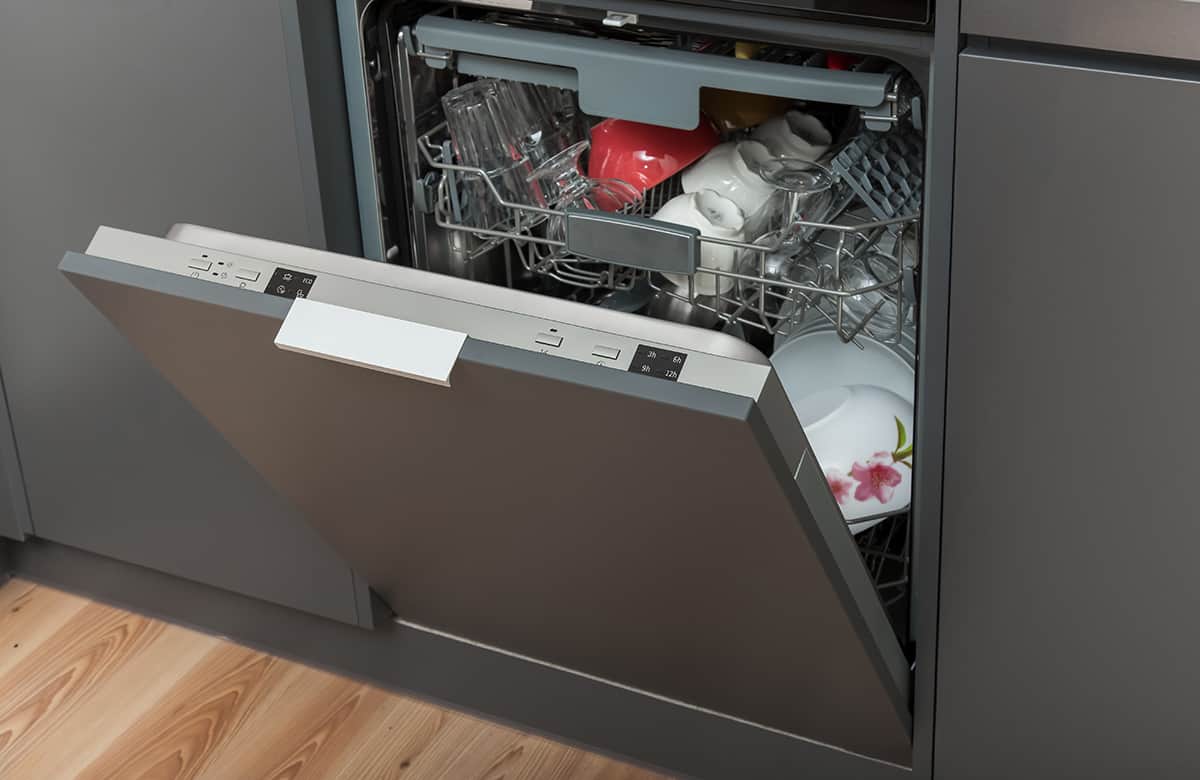Dishwashers are fantastic appliances that make our lives easier, but they need to be set up correctly to work their best. One key aspect of setting up a dishwasher is making sure it’s level. If your dishwasher isn’t level, it can lead to problems like leaks, poor cleaning results, and even damage to the appliance over time.
Here are the general steps for leveling a dishwasher:
- Place the dishwasher in its designated spot.
- Adjust the front feet till it’s balanced.
- Tweak the back feet for a perfect alignment.
- Use a level tool to confirm the dishwasher is straight and level.
In this article, we’ll explore the process of leveling a dishwasher in more detail, the tools you’ll need, and how to handle some common problems you might encounter.
What You Should Know Before Leveling a Dishwasher
Before you start leveling your dishwasher, there are several things you should know. This task requires some basic tools and safety measures. You should also know the different types of dishwashers and their unique leveling needs.
Essential Tools Required for Dishwasher Leveling
Leveling a dishwasher isn’t overly complicated, but you do need some specific tools. Here they are:
- Level—This tool checks if surfaces are horizontally or vertically straight. You’ll need it to confirm if your dishwasher is level.
- Adjustable wrench—You’ll use this to adjust the leveling feet of the dishwasher.
- Tape measure—This helps you measure the space where your dishwasher will go to ensure it fits and is properly centered.
- Protective gloves and eyewear—These are for your safety while working on the appliance.
Safety Measures to Adhere When Leveling a Dishwasher
Working with appliances requires attention to safety. Here are some key points:
- Turn off the power—Always disconnect the dishwasher from the electrical outlet before starting any work. If your dishwasher is hardwired, turn off the power from the circuit box.
- Avoid water sources—Keep the area dry to prevent any risk of electric shock.
- Use protective gear—Wear gloves and eyewear to protect yourself from sharp edges on the dishwasher or tools.
Understanding Different Dishwasher Types and Their Leveling Needs
Dishwashers come in different styles, each with its own leveling requirements.
- Built-in dishwashers—These are the most common type and are typically installed under a kitchen counter. They usually have four leveling feet, two at the front and two at the back.
- Portable and countertop dishwashers—These are smaller and can be moved around. They also have leveling feet, but their lightweight nature means they might require additional stabilization.
- Drawer dishwashers—These come in single or double-drawer designs. Leveling these involves adjusting feet on the bottom, just like with other types, but you also need to ensure the drawers are aligned correctly.
Step-by-Step Guide on How to Level a Dishwasher

Leveling a dishwasher might seem like a big job, but it’s really a series of small steps. Let’s break it down.
1. Preparing your dishwasher for leveling
Before you start adjusting, you need to get everything prepared.
- Unplug your dishwasher or turn off the circuit breaker for safety.
- Make sure the space where your dishwasher will go is clean and clear.
- Look at the feet of your dishwasher. They should be in good condition and move freely. If they’re damaged or stuck, you might need to replace them.
2. Placing the dishwasher in the designated spot
Now it’s time to place your dishwasher in its spot:
- Carefully move your dishwasher into its designated space. Make sure it’s not tilted to one side.
- Use your tape measure to confirm that the dishwasher is centered in its space.
3. Adjusting the front feet
With your dishwasher in place, you can start leveling:
- Place your level on top of the dishwasher. Check the bubble in the level. If it’s not centered, your dishwasher isn’t level.
- Use your adjustable wrench to turn the front feet. If the dishwasher is too low in the front, turn the feet to the right to raise it. If it’s too high, turn to the left to lower it.
- After adjusting, put your level back on top of the dishwasher. If the bubble is centered, the front is level. If not, adjust again.
4. Balancing the rear feet
Next, you’ll level the back:
- Move your level to the back of the dishwasher. Again, look at the bubble. If it’s off-center, the back isn’t level.
- Just like with the front, turn the back feet with your wrench. Right to raise, left to lower.
- Put your level back on top and check the bubble. If it’s centered, the back is level. If not, adjust again.
5. Checking the level
Finally, you’ll check that the entire dishwasher is level:
- This time, place the level diagonally on top of the dishwasher, from one corner to the other. Check the bubble. Adjust if needed.
- Place the level on the front of the dishwasher, from one side to the other. Again, check the bubble. Adjust if needed.
Troubleshooting Common Dishwasher Leveling Problems
Even with careful leveling, you may encounter some hiccups. Here’s how to troubleshoot common issues:
What to Do When Your Dishwasher Won’t Level
Sometimes, despite your best efforts, the dishwasher just won’t level:
- Stuck or damaged feet—If the leveling feet won’t turn, try using some WD-40 or similar lubricant to loosen them. If they’re damaged, you may need to order replacements.
- Uneven floor—If your kitchen floor is uneven, you might need to use shims (small pieces of wood or plastic) under the dishwasher’s feet to get it level.
- Too much wobble—If your dishwasher wobbles even after leveling, double-check that the legs are intact. Sometimes, wobbling can happen when there’s too much clearance between the dishwasher and the cabinet walls. You may need to readjust the mounting bracket or add shims.
Tips for Solving Leveling Problems
Here are some common issues and solutions:
- Dishwasher tilts when open—If your dishwasher tilts forward when you open the door, it’s likely too high in the front. Adjust the front feet to lower it.
- Dishes aren’t clean—If your dishes aren’t getting clean, the dishwasher may not be level. Check with your level and adjust as needed.
- Dishwasher leaks—If water leaks out from the dishwasher when running, your dishwasher might have been tilted. Check and adjust the leveling.
FAQs
1. What are the signs of an unleveled dishwasher?
If your dishwasher is unleveled, it might wobble or tilt, especially when you open the door. You might also see water leaking out during or after a wash cycle. The dishes may not come out clean because the water isn’t reaching them evenly.
2. How often should I check if my dishwasher is level?
Check that your dishwasher is leveled at least once a year. You should also check it anytime you move the dishwasher or if you start noticing any of the problems we talked about above.
3. Can I level a dishwasher myself, or should I hire a professional?
You can definitely try to level your dishwasher yourself. It’s not a very complicated job if you have the right tools and follow the steps carefully. But if you’re having trouble or you’re not comfortable doing it yourself, hiring a professional is a good idea.
4. What to do when dishwasher leveling feet are stuck or damaged?
If the leveling feet are stuck, you can try using a lubricant like WD-40 to loosen them. If they’re damaged, you’ll need to replace them. You can usually order new ones from the dishwasher manufacturer or a home improvement store.






